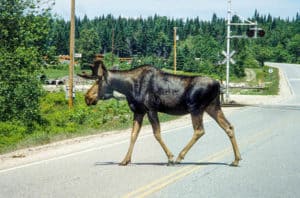Drivers need to be alert and cautious because moose are on the move, according to the Vermont Fish and Wildlife Dept. (VTF&W). Moose are more likely to be crossing roadways at this time of year, especially after dark or early in the morning because this is breeding season for moose.
“Motorists hit 49 moose on Vermont highways during 2021 and 23 so far this year,” said State Game Warden Major Justin Stedman. “We are asking drivers to be especially careful and for people to enjoy watching moose from a distance. Moose can be unpredictable and dangerous if you get too close and they feel cornered or get irritated.”

Vermont Fish &Wildlife cautions drivers that moose are more likely to be crossing roadways at this time of year, especially after dark or early in the morning.
Moose are a threat to motorists, but there are measures you can take to avoid hitting them, according to Fish and Wildlife.
Some include:
• Always be aware of the danger — moose cross the road randomly.
• Reduce your speed when you see “Moose Crossing” signs. When on secondary roads, the recommended speed is 40 mph or less in these areas.
• Drive defensively and don’t overdrive your headlights. Moose are more active at night and early morning, and can be difficult to see because of their dark color. If you see a moose ahead, slow down or stop.
Vermont highway sections most frequented by moose, include:
- Rt.105 from Island Pond to Bloomfield.
- Rt.114 from East Burke to Canaan.
- Rt.2 from Lunenburg to East St. Johnsbury.
- Interstate 91 at Sheffield Heights.
- Interstate 89 from Bolton to Montpelier.
- Rt. 12 from Worcester to Elmore.
- Rt 118 near Belvidere Corners and the Rt. 109 intersection.
Nineteen people have died in motor vehicle collisions with moose on Vermont highways since 1985.




